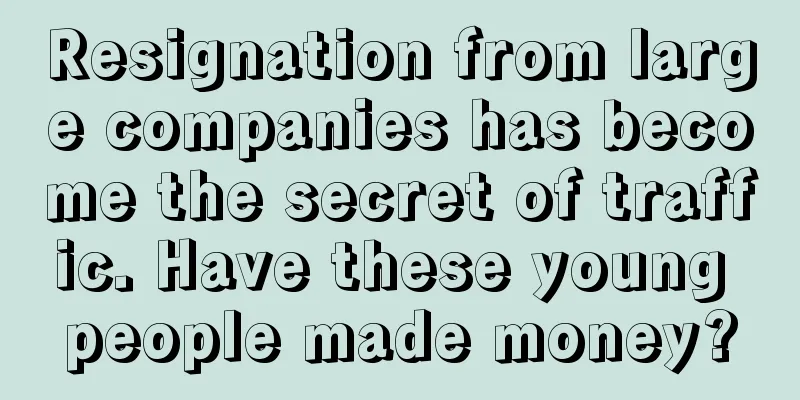Problems with new consumer brands

1. Where are the problems with new consumer brands?After experiencing the highlights of the past two years, new consumer brands such as Nayuki's Tea, Heytea, Perfect Diary, Pop Mart, Huaxizi, Linqingxuan, and Zhong Xuegao have fallen into collective silence, as if they had fallen from the altar overnight and became the "target of public criticism". They were the "hot cakes" that the investment circle was scrambling to grab the previous second, but the next second they seemed to have become "poison" that everyone avoided. What went wrong with them? What serious impact did the epidemic have on them? Are new consumer groups starting to "get tired of the old and like the new"? Traditional consumer brands began to use their corporate scale and financial advantages to launch a "massive counterattack". Coca-Cola is still the strong Coke, and Nestlé is still the world's number one Nestlé. "Hot or not" is just a phenomenon, and the phenomenon is never important. A thing will not become valuable from having no value just because it is "hot", nor will it lose its value just because it is "not hot". What is really important is to understand the essence behind the phenomenon. What went wrong with these new consumer brands? 2. Universal RuleIn August 2019, Diao Ye, who has some literary talent and can catch hot topics, published an article on his official account titled "Don't doubt it, the huge wave of "new consumption" is coming!" In it, he rewrote "In the Internet age, every industry is worth redoing" into "Every consumer product is worth redoing." This sentence has also become a slogan like a "Bible" in the process of waving the flag for new consumption and has been repeatedly mentioned. In Diao Ye's article, a point of view was put forward: "New media (Douyin, Kuaishou, and Xiaobian) + new channels (social/live streaming e-commerce) + new products (extreme cost-effectiveness) = new (consumer) brand" . This point of view has also become a universal rule that subsequent new consumer companies have regarded as a criterion. 3. “New Consumption” EnterprisesWhat capital fears is the lack of hot spots, and what entrepreneurs fear is the lack of concepts. In this way, entrepreneurs and investors in the new consumption sector easily get all of this; "Xiaohongshu is emotional, Zhihu is rational, Douyin and Kuaishou are live streaming, and Tmall is taking over traffic." People who have smelled the scent of wealth have come out one after another, and have copied and concocted a large number of so-called "new consumption" companies. Since 2020, more than 300 new consumption companies have received financing, an average of one per day. What needs to be understood is that new media, new channels, or the ultimate cost-effectiveness of products brought about by supply chain advantages are definitely not the fundamental factors that determine the success of consumer companies. The huge opportunities in the consumer industry are definitely not dependent on these factors. 4. Basic skills of consumer enterprisesWhether it is new media, new channels, or the extreme cost-effectiveness of products brought about by the advantages of the new supply chain, for any excellent consumer enterprise in the world, they should only be carriers for information dissemination, product sales, and satisfying user needs. Being able to make good use of these carriers: being able to do media placement, channel sales, and product production, are just the most basic skills of an excellent consumer enterprise. If someone thinks that as long as a company can master the above basic skills and seize these dividends, it can be successful and even defeat the giants. That is equivalent to saying that any product made by P&G, Coca-Cola, Unilever, and L'Oreal can be successful, but this is obviously ridiculous. Because the reality tells us that these excellent companies in the world, which are the best at marketing, channels, and products, have used almost the same methodologies that they have used to successfully create their most famous brands, and have produced too many failed products in the past hundred years. 5. Core competitiveness comes from internalIf a consumer goods company thinks that the expansion of information channels from "TV advertising" to "video websites", "social media" to "short videos" and the expansion of sales channels from "large supermarkets" to "convenience stores", "comprehensive e-commerce" to "vertical e-commerce", "social e-commerce" and "live streaming e-commerce" can shake its foundation, then it is definitely not a qualified consumer goods company. To put it another way: the bonuses of new media and new channels are called bonuses because they are available to all industries and categories from the first day of their birth. Therefore, if the core competitiveness of any enterprise comes from the use of external bonuses, it is doomed to not be a long-term successful enterprise. The core competitiveness of a truly excellent consumer goods enterprise must come from within, and it is doomed to succeed with or without these bonuses. 6. The success of consumer companies never depends on external dividendsLululemon, with a market value of more than 50 billion US dollars, grew under giants such as Nike and Adidas (in 2016, I emphasized the brand Lululemon in "Circle Business - Finding the Future Way Out for Enterprises"); Olaplex, with a market value of more than 15 billion US dollars, grew under giants such as Procter & Gamble/L'Oreal/Henkel; WhiteClaw, a sales legend with sales exceeding 3 billion US dollars in 2020, has snatched market share from giants such as Budweiser and Pernod Ricard. Is it just relying on dividends? The most well-known first-tier brands in the world today did not appear at the same time. They were established over hundreds of years of business history. In the past 100 years, brands that are considered successful today were established almost every year. Their continuity in the time dimension tells us that the success of consumer companies never depends on external dividends. 7. The key to success is not relying on DTCEvery time, someone thinks it’s different, this time is different, but the result is always the same. There is nothing new under the sun. A similar story has already happened once on the other side of the ocean. Since 2012, more than 500 consumer companies have received financing in the United States under the concept of DTC, but less than 1/10 of them have survived to this day. And the key to the success of less than 1/10 of them is not DTC. But such an obvious fact, almost a common sense in business, is ignored. Whenever new consumption is mentioned, new media and new channels are mentioned. I saw an interview with a popular new consumption founder before, who said, "The birth of all consumer products is accompanied by channel dividends. The rise of Procter & Gamble in the past was due to the dividends of Walmart's rise in the United States." Such a counterintuitive fallacy, such an easily falsified theory, is widely used as a code of conduct and copied by more new consumers. As the representative of the world's most successful consumer goods company, Procter & Gamble's success is by no means due to the rise of Walmart. 8. 99% of new consumer companies are doomed to be wrong from the moment they are bornMisreading business common sense, lacking the most basic respect for the essence of business, trying to start a business with the speculative thinking of "grabbing dividends", and having a shallow understanding of the essence of consumer goods, 99% of new consumer companies are doomed to be wrong from the moment they are born. This is especially true in the very mature consumer goods industry. 9. The core driving force of consumer enterprisesThere has always been only one core driving force for consumer companies, but most new consumer companies go against this. The only moat for companies is the understanding of user value. This standard applies to any industry, and the consumer industry is no exception. It can even be said that consumption is the industry that embodies this standard most vividly. Globally, the success of any consumer company we are familiar with must come from accurate insights into user needs. Most of the failed products launched by successful large consumer companies also stem from a deviation in the understanding of user value. 10. Understanding of User ValueProviding users with a more advanced, better-looking, and more cost-effective product is not called understanding of user value, that is just product design. Understanding of user value is the decisive factor. However, "understanding of user value" is a non-explicit thing, it cannot be directly presented to consumers. It is ultimately presented to consumers through a series of specific external manifestations such as product functions, image design, and advertising communication. So what is the core of driving consumption at the explicit level? The only correct answer is: brand. In hundreds of years of business history, no matter how the business environment evolves, even today, the only core factor driving consumer companies has never changed: it must still rely on brand drive . 11. Products are the basic skills of a companyMany people believe that brands come first and brands come second. As long as the product is good, consumers will recognize it. In the field of consumer goods, there is a classic case: in a blind test between Pepsi and Coca-Cola, consumers who participated in the blind test generally felt that Pepsi tasted better than Coca-Cola. What's more interesting is that if the testers were told that they were drinking Coca-Cola before the blind test, the proportion of people who liked Coca-Cola was 49%, and if they were not told, only 29% liked Coca-Cola. However, Coca-Cola's sales have always far exceeded Pepsi in the past 100 years. Simply put, Coca-Cola is definitely not the best-tasting cola. There are certainly many companies that can make cola taste better, but they cannot shake the position of cola. Starbucks is definitely not the best coffee company in the world, IKEA is definitely not the best furniture company in the world, Hermès is definitely not the best-looking bag, Head & Shoulders is definitely not the best shampoo, Budweiser is definitely not the best-tasting beer... Products are only as good as one company's basic skills. 12. Brand building - the core strategyConsumer goods companies need to regard brand building as their core strategy from the first day of the brand’s birth, in order to truly become a successful company and gain continued support from new consumer groups. 13. BrandBrand is the sum of all consumer purchase behaviors and is the awakening machine of consumer consciousness. In the consumer goods industry, with the blessing of a brand recognized by consumers, a company will be omnipotent in its field and difficult for competitors to shake. At the same time, brand is also the most fundamental and decisive factor in reducing user decision-making costs. 14. Influencing users’ consumption decisionsTo promote a user's consumption behavior, the most important thing is to influence the user's consumption decision. Therefore, most of the efforts of a consumer enterprise are to achieve this goal: investing more in research and development, making more aesthetic designs, finding celebrity endorsements, placing a large number of advertisements, finding KOLs to recommend products, finding expert reviews, distributing products through all channels, reducing prices and providing better services, etc. Almost all the strategies you can think of are aimed at influencing users' consumption decisions. Then you need to know that 99% of the consumer decisions are irrational. It is a process that is influenced by many different factors and has no fixed logic. It has even led to many disciplines: consumer behavior, behavioral economics, consumer psychology, etc. In other words, consumers will not study your product technology, cost structure, artistic value, calculation function utility and price cost model... If you have read Thinking, Fast and Slow, you will fully understand the human decision-making mechanism. 15. "Basic Plate" + "Incremental Plate"The sales of a brand should be composed of "basic market" + "incremental market" . The brand brings the "basic market" and the marketing means bring the "incremental market". This is the state of a healthy consumer brand. For consumer companies, they should focus their core energy on improving the "basic market" instead of investing 99% of their energy in "incremental market". 16. Do the Hard and Right ThingTo build a brand, you must do these five steps well. The first step is to find a clear brand positioning. The second step is to establish unique brand differentiation. The third step is to maintain a high degree of continuity in the information conveyed by the brand. The fourth step is that the importance of brand advertising is far higher than digital performance advertising. The fifth step is to keep in mind that the purpose of branding is to achieve product premium, not cost-effectiveness. All brand behaviors are born out of the pursuit of premium. For consumer brands or enterprises, "doing the difficult but right thing" is not an option, but the only option. Too many correct decisions are difficult, and most of the so-called simple things are wrong. 17. Grasping the essence of new consumptionThere is nothing new under the sun. To do a good job in new consumption, we must grasp the essence, find the first principles of building a good new consumer brand, and then make full use of the new X to promote the growth of the brand (new groups, new media, new lifestyles, new channels), so that we can truly succeed in the consumer goods track. Otherwise, it will only be a flash in the pan! Author: Liu Yichun Source: WeChat public account "Liu Yichun's Brand Business Innovation (ID: shangyeyiguohui)" |
<<: How do Internet newcomers choose careers, industries, and companies (Part 1)
>>: It is popular among primary school students to wear bracelets. What do you think about it?
Recommend
Is the Amazon Buy Box Win Rate High? How to Improve It?
There are many consumers shopping on the Amazon pl...
How can a new Shopee store gain traffic? Is there any method?
Now, more and more merchants are opening stores on...
What are the cross-border e-commerce platforms in China? How to choose?
Nowadays, you need to find a suitable platform to ...
Most people have cognitive biases about Xiaohongshu e-commerce...
The real opportunity of Xiaohongshu e-commerce - p...
"Wen Huijun"'s Magic Red
The "Yu Wenliang phenomenon" has ended, ...
Is the Meikeduo e-commerce platform easy to operate? What is its use?
If you want to do e-commerce now, there are actual...
Is Amazon operation suitable for long-term operation? How to operate it?
Amazon customer service operations and other posit...
What is the first step after opening a store on Shopee Indonesia? How did Shopee Indonesia start?
Opening a Shopee store in Indonesia is a promising...
Which products cannot be sold to Russia? Which categories are easy to sell in Russia?
As global trade continues to prosper, many people ...
B Station "Creates" Hupu Goddess
This article starts with the voting for the Hupu G...
The hidden thoughts behind free shipping on e-commerce platforms
Does free shipping affect your purchasing decision...
Death of an Algorithm Engineer
In the wave of digital transformation, algorithm e...
How to attract traffic to a new Shopee store? What are the methods?
Shopee is a relatively well-developed cross-border...
Luckin Coffee burst the "oat latte price bubble" this time
Luckin Coffee launched OATLY oat latte at a price ...
Looking at Double 11 from the list: What happened in the past three years?
Every time a big promotion ends, the rankings alwa...









